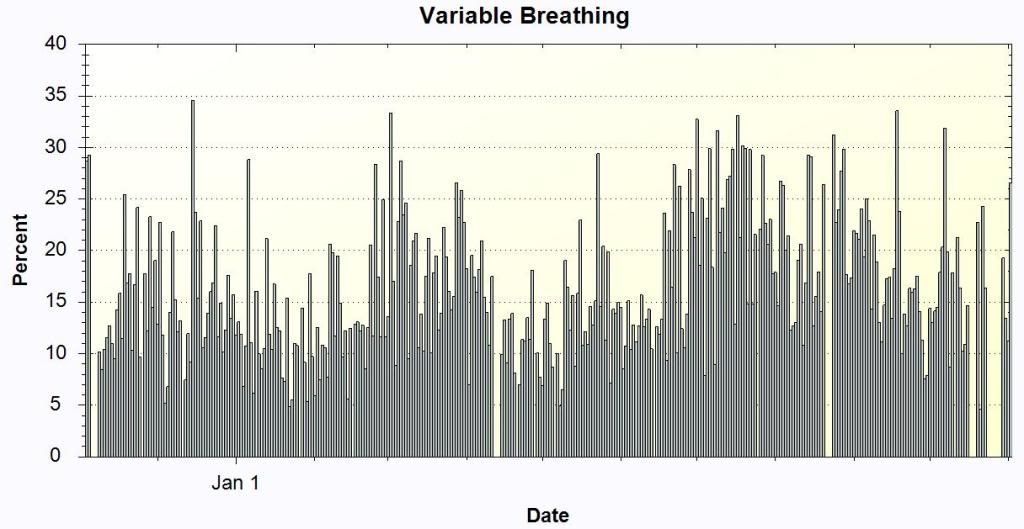Some interpetations from the patent at
http://www.google.com/patents?id=lcB-AA ... xy_is=2008
To see the various controllers see diag called Fig 2 but shown at the bottom of the above link as Drawings (page 4). Page 27 of the patent describes fig 2 and shows Variable Breathing controller as the 2nd last priority.
Page 29 starts of describing the
D.Flow LImitation Control Layer,
E.Snore Control Layer,
F.Big Leak Control Layer,
G.Apnea/Hypopnea Control Layer,
H.Variable Breathing Control Layer,
To see the way Respironics treat VB see 177 on (I have bolded and underline core aspects of VB - this is to try and get some consensus as to what various members here are talking about when referring to VB as it seems to me there is still a lot of confusion whereas PB (Periodic Breathing) can be very easily explained & backed up by references, VB hasn't been.
**************************************************************************************************************************************************
'Claim 3: a variable breathing control layer that monitors the flow signal to determine whether the patient is experiencing erratic breathing, and causes the pressure generating system to adjust the pressure of the flow of breathing gas responsive to detection of erratic breathing'
Variable Breathing is one of the lowest priority controllers (as per Fig 2).
'The system of claim 3, wherein: (1) the flow limit control layer has a higher priority than the snore control layer, the big leak control layer, the apnea/hypopnea control layer, the variable breathing control layer, and the auto-CPAP control layer; (2) the snore control layer has a higher priority than the big leak control layer, the apnea/hypopnea control layer, the variable breathing control layer, and the auto-CPAP control layer and has a lower priority than the flow limit control layer; (3) the big leak control layer has a higher priority than the apnea/hypopnea control layer, the variable breathing control layer, and the auto-CPAP control layer and has a lower priority than the flow limit control layer and the snore control layer; (4) the apnea/hypopnea control layer has a higher priority than the variable breathing control layer, and the auto-CPAP control layer and has a lower priority than the flow limit control layer, the snore control layer, and the big leak control layer; and (5) the variable breathing control layer has a higher priority than the auto-CPAP control layer and has a lower priority than the flow limit control layer, the snore control layer, the big leak control layer, and the apnea/hypopnea control layer.'
*****************************************************************************************************
[0159] H. Variable Breathing Control Layer
[0160] The Auto-CPAP controller, which is described in the next section, relies on the ability to trend the steady rhythmic breath patterns associated with certain stages of sleep. When a patient is awake, in REM sleep, or in distress, breathing tends to be more erratic and the Auto-CPAP trending becomes unstable. It is, therefore, important to interrupt the Auto-CPAP controller if the patient's breathing pattern becomes too variable. In essence, the variable breathing control layer keeps the Auto-CPAP control layer from being too erratic.
[0161] Referring back to FIG. 2, the variable breathing control layer, which is assigned a seventh (7th) priority, includes a variable breathing detector 270, a variable breathing monitor 272, and a variable breathing controller 274. As described in greater detail below, the variable breathing control layer performs statistical analysis on the scatter of the trended weighted peak flow data
to detect unstable breathing patterns or abrupt changes in patient response. When activated, variable breathing control module 274 takes priority over the auto-CPAP controller, so that when a valid variable breathing indication is provided by variable breathing monitor 272, control of the pressure support system is turned over to the variable breathing controller. In short, activation of variable breathing control module 274 interrupts the operation of the auto-CPAP controller when breathing becomes unstable and appropriately manages any necessary pressure changes.
[0162] 1. Variable Breathing Detection and Monitoring
[0163] Variable breathing detection module 270 monitors the weighted peak flows Q.sub.Wpeak over a moving window, which in a presently preferred embodiment, is a four (4) minute window. The detection module in essence trends four minutes worth of weighted peak flow information to determine whether this information is becoming too erratic. FIGS. 10A and 10B are graphs illustrating examples of the scatter of weighted peak flows. In FIGS. 10A and 10B, the weighted peak flows are relatively closely bunched around a trend line 276 in area 278 and is relatively scattered from the trend line in area 280. Trend line 276 is a best-fit line determined using any conventional statistical analysis technique based on the weighted peak flows data collected during the current 4 minute window. The primary difference between FIGS. 10A and 10B is that the trend line in FIG. 10B is shown with a non-zero slope. This is done to highlight the fact that the trend line is a best-fit line based on the collected data points.
[0164] Variable breathing detection module 270 determines the standard deviation of the weighted peak flow data collected during the monitoring window as indicated by dashed lines 282. It should be noted that the standard deviation is calculated based on the best-fit trend line 276. It can be further appreciated that a standard deviation 284 is less in region 278 than a standard deviation 286 in region 280, indicating that the weighted peak flow data is more variable in region 280.
[0165] The present inventors appreciated that using the standard deviation alone as a measure of the degree of variation in the weighted peak flow data may not produce consistently correct results. This is so, because the standard deviation of the weighted peak flow data when the mean patient flow is relatively low is not exactly comparable to the same standard deviation for a higher mean patient flow. The present invention, therefore, seeks to normalize the standard deviation to the mean patient flow, and then takes the mean flow into consideration when analyzing the variation in the data.
[0166] FIG. 11 is a chart illustrating a normalization curve 290 that describes the relationship between the mean patient flow and an adjusted mean patient flow. It can be appreciated from reviewing this figure that there is a linear region 292 in which the adjusted mean flow (vertical axis) has a one-to-one match with the actual mean flow (horizontal axis). If the patient's mean flow for the 4 minute window is within region 292, no adjustment to this mean flow is made. There is also a first region 294 having a 1/2 to one relationship between the adjusted mean flow and the actual mean flow. Thus, if the actual mean flow falls within region 294, which is between 15 and 25 liters per minute (lpm), then an adjusted mean flow is calculated based on curve 290. There is also a flat region 296 where the adjusted mean flow is clamped to a baseline value even if the actual mean flow is decreased. Thus, if the actual mean flow is less than 15 lpm, the adjusted mean flow is clamped at 20 lpm.
[0167] It is to be expressly understood that the specific shape of curve 290 and the delineations between the various regions is subject to variation. For example, although not illustrated, the present invention further contemplates providing this clamping feature if the mean flow exceeds a predetermined value, such as in region 298.
[0168] A variable breathing number (VB#) is calculated as follows: 1 VB # = standard deviation adjusted mean flow . ( 1 )
[0169] The end result of the variable breathing detection process carried out by variable breathing detection module 270 is this variable breathing number. The higher the VB#, the more variable the weighted peak flow data.
[0170] The variable breathing number is provided by variable breathing detection module 270 to variable breathing monitoring module 272, which compares this number to threshold values to determine when to request that variable breathing controller 274 take control from the auto-CPAP controller. FIG. 12 is a chart illustrating the hysteresis threshold criteria for declaring that the patient is experiencing variable breathing and, hence for requesting control of the pressure support system.
[0171] As shown in FIG. 12, an upper threshold 300 and a lower threshold 302 are set in advance. Preferably, the values of these thresholds are determined from empirical data. Variable breathing monitor 274 declares there to be variable breathing and issues a request for control to request processor 106, when the variable breathing number (VB#), represented by line 304, exceeds upper threshold 300. This occurs at point 306 in FIG. 12. Variable breathing monitor 274 will continue to deem there to be variable breathing, and, hence, continue to request control, even if the VB# falls below upper threshold 300. In short, a variable breathing active indication is turned on at point 306 and remains on over region 308, until the VB# falls below lower threshold 302 at point 310. While the variable breathing active indication is on, variable breathing monitor 274 issues a request for control of the pressure support from request processor 106.
[0172] Similarly, variable breathing monitor 274 will continue to deem there to be no variable breathing, and, hence, will not request control, even if the VB# rises above lower threshold 302. That is, the variable breathing active indication is turned off at point 310 and remains off over region 312, until the VB# exceeds upper threshold 300, which occurs at point 314.
[0173] 2. Variable Breathing Pressure Control
[0174] Once variable breathing controller 274 has been granted control of the pressure support system, it takes some initial action based on that action the auto-CPAP controller discussed below is taking. After this initial action, it performs an independent pressure control operation. FIG. 13 is a chart illustrating the pressure control operation of the variable breathing control module of the present invention.
[0175] As shown in FIG. 13, the pressure control operation performed by variable breathing controller 274 is subdivided into the following three regions: a) an active response region 320, b) a pressure hold region 322, and c) a slow ramp region 324. The pressure control performed by variable breathing controller 274 in each of these regions is discussed in turn below. It is to be understood that even though there appears to be discontinuities in the delivered pressure in FIG. 13, this is only due to the manner in which each region is illustrated. In practice, the pressure at the end of region 320 is the start pressure for the pressure control that takes place in region 322. Similarly, the pressure at the end of region 322 is the start pressure for the pressure control that takes place in region 324.
[0176] In region 320, column A illustrates the possible prior pressure curves, i.e., the possible pressure control actions being taken by the pressure support system before operation of the system was handed over to variable breathing controller 274. Column B illustrates the corresponding pressure control curves that are produced by variable breathing controller 274 based on the prior curves. In case #1, a prior pressure 326 is flat (not increasing, not decreasing). In which case, variable breathing controller 274 will cause the pressure delivered to the patient to remain at this level, as indicated by pressure curve 328.
[0177] In case #2, a prior pressure 330 is increasing. In which case, variable breathing controller 274 initially decreases the pressure delivered to the patient at a rate of 0.5 cmH.sub.2O per minute, as indicated by pressure curve 332. The magnitude of the decrease is dependent on the magnitude of the increase in prior pressure 330. Pressure decrease 332 is intended to erase the prior pressure increase 330 that possibly caused the variable breathing. However, the total decrease in pressure drop 332 is limited to 2 cmH.sub.2O. After pressure decrease 332, variable breathing controller 274 holds the pressure steady, as indicated by pressure curve 334.
[0178] In case #3, a prior pressure 336 is decreasing. In which case, the variable breathing controller initially increases the pressure delivered to the patient at a rate of 0.5 cmH.sub.2O per minute, as indicated by pressure curve 338. The magnitude of the increase 338 is dependent on the magnitude of the decrease in prior pressure 336. Pressure increase 338 is intended to erase the prior pressure decrease 336 that may have caused the variable breathing. However, the total increase in pressure 338 is limited to 2 cmH.sub.2O. After pressure increase 338, variable breathing controller 274 holds the pressure steady, as indicated by pressure curve 340.
[0179] In a presently preferred embodiment, the duration during which pressure is provided according to the paradigms discussed above for region 320, column B, is set to 5 minutes. Thus, pressure curve 328 (case #1), curve 332-334 (case #2), or curve 338-340 (case #3) is provided for 5 minutes or until the variable breathing condition clears. Thereafter, the pressure is controlled according the pressure operations of region 322. It is to be understood, however, that this duration can be varied over a range of durations.
[0180] In region 322, the pressure is either maintained at a constant value, as indicated by pressure curve 342 (case #4), or it follows a decrease and hold pattern, as indicated by pressure curve 344 (case #5). The decision to hold the pressure (case #4) or to decrease the pressure (case #5) is made by comparing the current pressure, i.e., the patient pressure at the end of region 320, with the snore treatment pressure. This is similar to the pressure control operation of A/H controller 168 discussed above with respect to FIG. 9.
[0181] If there is no snore treatment pressure stored in the system, which will be the case if the snore controller has not been activated, the pressure is held constant as pressure curve 342. If there is a snore treatment pressure, and if the current pressure is more than a predetermined amount above this snore treatment pressure, such as more than 2 cmH.sub.2O above the snore treatment pressure, variable breathing controller 274 decreases the pressure to a level that is a predetermined amount higher than the snore treatment pressure, as indicated by pressure curve 344, and holds the pressure at the lower level, as indicated by line 346, over the duration of region 322. The present invention decreases the pressure during pressure decrease 344 to the snore treatment pressure +1 cmH.sub.2O.
[0182] In a presently preferred embodiment, the duration during which pressure is provided according to the paradigms discussed above for region 322 is set to 15 minutes. Thus, pressure curve 342 (case #4) or curve 344-346 (case #5) is provided for 15 minutes or until the variable breathing condition clears. Thereafter, the pressure is controlled according to the pressure operation of region 324. It is to be understood, however, that this 15 minute duration can be varied over a range of durations.
[0183] In region 324, there is only one pressure control operation. Namely, the pressure delivered to the patient is slowly ramped down, as indicated by pressure curve 348. This downward pressure ramp continues until the minimum system pressure is reached or until the variable breathing condition clears.
















